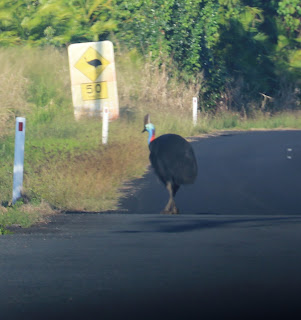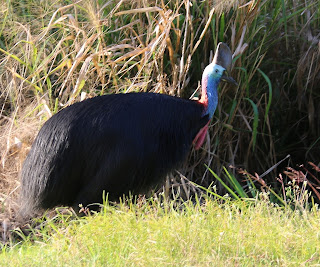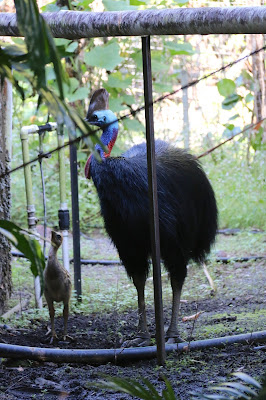The cassowaries are looking for water in the dry, hot spring weather as many rainforest creeks have already stopped flowing. I think it is going to be a hard long summer.
Cassowary dad, Snout, is regularly bringing his chick to the nursery sediment pond.

A young lady called Beatrix Molly from South Australia, has written to me and suggested 'Kin' as the name for this new chick. Thank you for this lovely name Bea, it can signify the special bond between cassowary dads and their offspring and the role the dad plays in sitting on the eggs and raising the chicks. It is also a neat idea to keep the named offspring of each cassowary with the same alphabetical first letter. Something I hadn't thought of doing but you serendipitously did Bea.
Cassowary chick Kin has exceptionally large feet and sturdy legs and is robust and naturally curious, typical for a young cassowary. Kin loves playing in the mud and when Snout lies down to rest, Kin explores the rainforest floor but never ventures more than a few metres away from his dad.
Cassowary Gregory has been at the tip of Coquette Point for a month now and this week he challenged Snout and won.
Snout and little Kin were drinking at the pond when Gregory turned up. Gregory stood tall and stretched his neck as high as it would go as he slowly approached Snout while walking on tippy toes. There was no vocalisation just a play of dominance, a 'shirt-front' standoff between these two magnificent birds.
 Cassowary Snout decided
Cassowary Snout decided it was not worth risking the
it was not worth risking thesafety of his chick in a fight with Gregory and he walked
away up the hill with
little Kin beside him.
Cassowary Gregory watched them go, stretching his neck in order to see them. The whole episode passed without any striking or force and at no time was there any audible vocalisation.
Matriarch Cassowary Jessie seems to have lost her flightiness and although I have only seen her twice this week, she was walking slowly on both occasions and did not appear to be at all concerned by my presence in her rainforest home.
Cassowary Queenie has shown up again and appears to have taken up residence in 'Mozzie Mecca'. This is the Council approved but put 'on hold', Sea Haven development at Ninds Creek, Innisfail. I followed Queenie and watched her enter a tunnel in the Guinea grass beside the road. She disappeared into the littoral rainforest beyond. It was good to see her still in the same area.



Cassowary Ky has been wandering further and possibly over to the other side of the Moresby Range. There are several days when I do not see him and I hear reports of people sighting him elsewhere. Unfortunately, he is chased by all the other cassowaries. However, he is looking well and strides around confidently.

The pattern on Ky's rear neck is starting to take shape.
The tides were just right this week to walk the beach at first light.

The pre dawn light coloured the sea and sand purple and the 1,622 m of Mt Bartle Frere loomed Bartle-blue over the Johnstone River estuary.
As the sun rises the red, blue and purple quickly turn to orange and grey. Terns, whimbrels and pelicans took to the air to commence the day's foraging in the upstream waters of the Johnstone River.
Above, five pelicans flew from their roost on the rookery and headed up the Johnstone River.

 Other whimbrels were already feeding on the sandbanks.
Other whimbrels were already feeding on the sandbanks.Out to sea the endless line of ghostly bulk carriers emerged through the haze as they navigate the sea-passage of the GBRMP.

 Most of the terns, with a good deal of chatter,
Most of the terns, with a good deal of chatter,circled then headed out to sea.
One pelican outsider wanders down to the water as the sun's blast of light emerges from the thick layer of horizon cloud. Just as suddenly the air is hot as the breeze drops away.


Around thirty whimbrels
were on the beach, some flew up the river while the rest hunted for crabs on the sand banks.

One greater sand plover was doing his pilates exercise, as he stood on one leg, the other stretched out awkwardly behind him. While elsewhere, lesser sand plovers were holding races on the beach.


All the birds were suddenly abuzz with activity as the sun rose in the sky.
Pied oyster catcher poked his beak deep into the sand in search of a crab. Collard kingfisher sung happily from the dead branch of a tree flipping his tail in anticipation of the awakening day.


Common sandpipers, mostly solitary now, were racing along the ridges looking for tardy fish which may have been caught out in the retreating tide. While old beach stone curlew walked out from behind the sand dunes and surveyed his kingdom.



Red-capped plovers spread out over the sandbanks and amongst them were newly arrived Pacific golden plovers.
Old white faced heron was a study of concentration as he watched the entrance to a crab hole, just waiting to pounce on such a tasty treat.
 |
The tide turned and I reluctantly also turned to go home.
Late in the afternoon I returned to the beach and I stayed until last light.
When I arrived I saw the pied oyster catchers had gathered together and tucked their beaks up for the night.
The terns gathered on the beach facing into the fresh hot wind which had just emerged from the North, the first for the season.

Only three pelican returned and they landed in the water and walked up the beach one, two, three.
The once vast Coquette Point mangrove forest on the seaward side has almost totally died. In the falling light of dusk the few remaining trees, reflected in the still water, a reminder of what had gone. All along the beach on the Ocean side the dune system, during big tide events, is now regularly overtopped. Where will the seabirds roost?

Just as I was about to leave, to my utter amazement two pelicans arrived and with them were eight
Radjah Shelducks they landed in the water and swam in the open estuary.
By this time dusk was turning quickly to dark and I headed up the River, but still on a falling tide, so there was no problem in crossing Crocodile Creek.
The reds and purples that accompanied sunrise were back in the sky at sunset. I headed home, hearing the sound of the ducks happily squabbling as they played in the low surf behind me.


Early the next morning I was delighted to find two white bellied cuckoo shrike chittering away in the melaleuca trees as they searched for insects.
Rainbow bee-eaters are busily eating all the pest insects from my nursery and the little sunbirds are building nests in every hanging branch they can find. Spring has sprung and every bird is busy.

Mrs diamond dove has built her nest in the heart of a coconut tree while Mr stands guard on the roof of the house close by.


The Clean Rivers Campaign is underway and the following media release went out this week.
Cheers this week,
Yvonne




























No comments:
Post a Comment